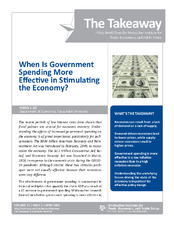| dc.creator | Jo, Yoon J. | |
| dc.date.accessioned | 2022-05-02T22:04:21Z | |
| dc.date.available | 2022-05-02T22:04:21Z | |
| dc.date.issued | 2022-04 | |
| dc.identifier.uri | https://hdl.handle.net/1969.1/195988 | |
| dc.description | The recent periods of low interest rates have shown that fiscal policies are crucial for economic recovery. Understanding the effects of increased government spending on the economy is of great importance, particularly for policymakers. The $800 billion American Recovery and Reinvestment Act was introduced in February, 2009, to resuscitate the economy. The $2.2 trillion Coronavirus Aid, Relief, and Economic Security Act was launched in March, 2020, in response to the economic crisis during the COVID-19 pandemic. Although similar, these two stimulus packages were not equally effective because their recessions were very different. | en |
| dc.language.iso | en_US | |
| dc.publisher | Mosbacher Institute for Trade, Economics & Public Policy | |
| dc.relation.ispartofseries | Volume 13;Issue 2 | |
| dc.rights | Attribution-NonCommercial-NoDerivatives 4.0 International | en |
| dc.rights.uri | http://creativecommons.org/licenses/by-nc-nd/4.0/ | |
| dc.subject | government stimulus | en |
| dc.subject | recession | en |
| dc.title | When Is Government Spending More Effective in Stimulating the Economy? | en |
| dc.type | Article | en |
| dc.contributor.sponsor | Bush School of Government and Public Service | |
| local.department | Other | en |



